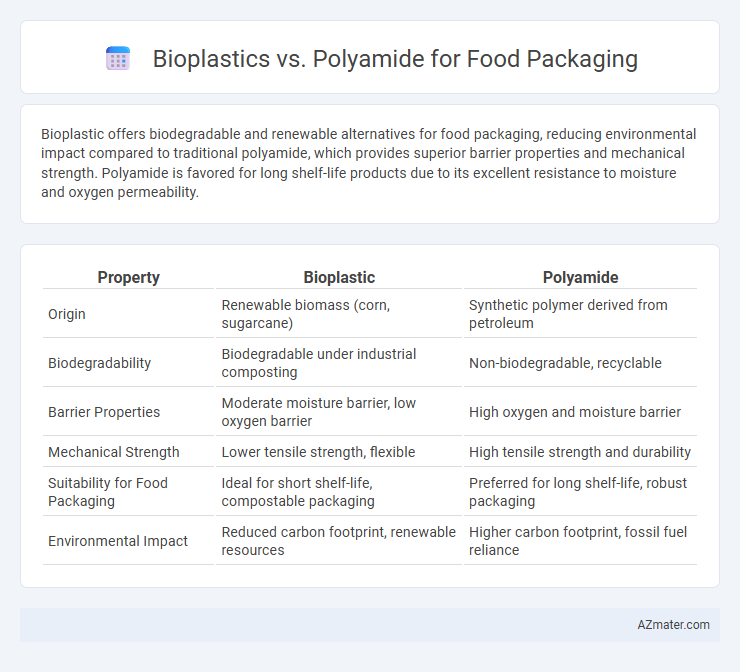Bioplastic offers biodegradable and renewable alternatives for food packaging, reducing environmental impact compared to traditional polyamide, which provides superior barrier properties and mechanical strength. Polyamide is favored for long shelf-life products due to its excellent resistance to moisture and oxygen permeability.
Table of Comparison
| Property | Bioplastic | Polyamide |
|---|---|---|
| Origin | Renewable biomass (corn, sugarcane) | Synthetic polymer derived from petroleum |
| Biodegradability | Biodegradable under industrial composting | Non-biodegradable, recyclable |
| Barrier Properties | Moderate moisture barrier, low oxygen barrier | High oxygen and moisture barrier |
| Mechanical Strength | Lower tensile strength, flexible | High tensile strength and durability |
| Suitability for Food Packaging | Ideal for short shelf-life, compostable packaging | Preferred for long shelf-life, robust packaging |
| Environmental Impact | Reduced carbon footprint, renewable resources | Higher carbon footprint, fossil fuel reliance |
Introduction to Food Packaging Materials
Bioplastic and polyamide represent two distinct categories of food packaging materials, each with unique properties influencing their performance and environmental impact. Bioplastics, derived from renewable biomass sources like corn starch or sugarcane, offer biodegradability and reduced carbon footprints, making them attractive for sustainable packaging solutions. Polyamide, a synthetic polymer known for exceptional barrier properties, mechanical strength, and thermal resistance, excels in preserving food freshness and extending shelf life despite being petroleum-based and less eco-friendly.
Overview of Bioplastic and Polyamide
Bioplastics are derived from renewable biomass sources such as corn starch or sugarcane, offering biodegradability and reduced carbon footprint compared to conventional plastics. Polyamide, commonly known as nylon, is a synthetic polymer renowned for its high mechanical strength, barrier properties, and resistance to heat and chemicals, making it suitable for durable food packaging. Both materials serve distinct roles: bioplastics emphasize environmental sustainability, while polyamides prioritize performance and protection in food packaging applications.
Environmental Impact: Bioplastic vs Polyamide
Bioplastic food packaging significantly reduces environmental impact by being derived from renewable resources and exhibiting biodegradability under industrial composting conditions, leading to lower greenhouse gas emissions compared to conventional plastics. Polyamide, while offering excellent barrier properties and durability for food preservation, is petroleum-based and contributes to higher carbon footprints and persistent plastic waste issues due to its resistance to degradation. Choosing bioplastic over polyamide aligns with circular economy principles by minimizing landfill accumulation and promoting sustainable resource utilization in food packaging applications.
Barrier Properties and Shelf Life
Bioplastic and polyamide differ significantly in barrier properties impacting food packaging performance; polyamide excels in oxygen and aroma barrier resistance, prolonging shelf life for oxygen-sensitive products. Bioplastics offer moderate moisture barrier but often lack the superior gas impermeability of polyamides, limiting their use with highly perishable foods. Advances in bioplastic formulations and multilayer structures aim to enhance barrier efficiency, bridging the shelf life gap compared to traditional polyamide packaging.
Mechanical Strength and Durability
Bioplastics offer moderate mechanical strength and biodegradability, making them suitable for short-term food packaging but less durable under heavy stress or prolonged use. Polyamide (nylon) exhibits superior mechanical strength, impact resistance, and thermal stability, ensuring long-lasting durability and protection for food products. The choice depends on the balance between sustainability preferences and the need for robust, durable packaging materials.
Food Safety and Regulatory Compliance
Bioplastic food packaging offers advantages in food safety due to its biodegradable nature and reduced chemical migration risk, aligning with stringent FDA and EFSA regulations. Polyamide packaging provides superior barrier properties against gases and moisture, enhancing shelf life while meeting EU Regulation No 10/2011 compliance standards for food contact materials. Both materials must undergo rigorous testing for migration limits, ensuring adherence to global food safety protocols and minimizing contamination risks.
Cost Analysis and Economic Viability
Bioplastic for food packaging offers lower environmental impact but generally incurs higher initial material costs compared to polyamide, which benefits from established manufacturing processes and economies of scale, resulting in lower unit costs. Polyamide's cost-effectiveness is reinforced by its superior barrier properties and durability, reducing spoilage and waste, whereas bioplastics may require further technological advancements to achieve comparable performance at competitive prices. Economic viability hinges on balancing bioplastic sustainability incentives and potential regulatory benefits against the higher production expenses relative to conventional polyamide materials.
Compostability and End-of-Life Options
Bioplastics offer superior compostability compared to polyamides, breaking down efficiently in industrial composting facilities within 90 to 180 days, thereby reducing landfill waste and greenhouse gas emissions. Polyamide packaging, while durable and flexible, is largely non-compostable and requires mechanical recycling or incineration, posing challenges in waste management and environmental impact. Choosing bioplastics enhances circular economy strategies by providing renewable, biodegradable options aligned with sustainable packaging goals in the food industry.
Market Trends and Consumer Preferences
Bioplastic for food packaging is gaining traction due to increasing environmental concerns and regulatory support promoting sustainable materials. Polyamide remains favored for its excellent barrier properties and mechanical strength, especially in premium food products requiring extended shelf life. Market trends indicate growing consumer preference for eco-friendly packaging, driving innovation in bioplastic formulations to match polyamide's performance.
Future Prospects and Innovations
Bioplastic food packaging shows promising future prospects due to its biodegradability and reduced environmental impact, with innovations focused on enhancing barrier properties and mechanical strength through advanced polymer blends and nanocomposites. Polyamide packaging offers superior oxygen and moisture barrier performance essential for preserving food freshness, with ongoing research targeting bio-based polyamides to improve sustainability. Emerging technologies in both materials emphasize smart packaging features such as active and intelligent packaging for extended shelf life and real-time food quality monitoring.

Infographic: Bioplastic vs Polyamide for Food packaging
 azmater.com
azmater.com